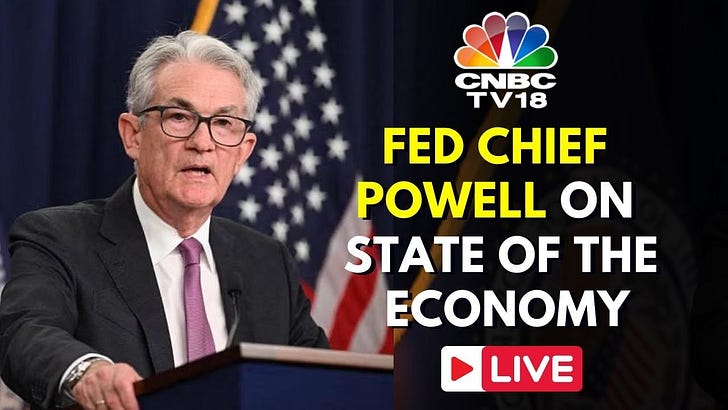Federal Reserve Chair Jerome Powell Speaks at the Economic Club
Trump Tariffs | US Stock Market | CNBC TV18 CHICAGO
Federal Reserve Chair Jerome Powell speaks on the economic outlook before the Economic Club of Chicago, in Chicago, Ill. all eyes will be on Federal Reserve Chair Jerome Powell when he speaks at The Economic Club of Chicago on April 16. The market will be keenly watching his upcoming commentary on Wednesday. Global investors, analysts, and market participants would be looking to Powell for guidance on a number of recent developments. Powell’s comments could shed light on a variety of issues, including tariffs, jobs, inflation, direction of interest rates, and the state of the economy. U.S. Treasury Secretary Scott Bessent announced Monday that the White House will begin interviewing applicants for the position of Federal Reserve Chair Jerome Powell, whose tenure ends in May 2026. Powell has been under pressure sort of to bring the interest rates down. Inflation in the US seems to be trending lower. The latest set of US CPI data for March, released on April 10, 2025, showed a falling trend. Whether the US Fed FOMC decides to go for a rate cut in May or wait for June remains to be seen.
Most Recently…
Fed Acknowledges Economic Softening Amid Tariff Overhang
Prepared remarks delivered by Federal Reserve Chair Jerome Powell on Wednesday signal a deceleration in U.S. economic growth, with early indicators pointing to a weaker first quarter. Modest consumer spending, a surge in preemptive imports to beat tariff deadlines, and declining sentiment among households and firms are among the cited headwinds.
Speaking before the Economic Club of Chicago, Powell emphasized that while the economy remains fundamentally sound, “the data in hand so far suggest that growth has slowed in the first quarter from last year’s solid pace.” That assessment is not new but underscores an evolving macroeconomic backdrop increasingly shaped by trade disruptions.
Structural Drag from Trade Policy and Sentiment
The chair’s language reflects heightened concern over the economic toll exacted by the Trump administration’s aggressive tariff strategy. While Powell stopped short of attributing the slowdown directly to trade tensions, he pointed to “elevated uncertainty about the outlook” and a “sharp decline in sentiment” from both businesses and consumers—effects that many external analysts tie squarely to tariff instability.
Though the tariffs are still “evolving,” Powell noted, their eventual footprint “is likely to be larger than anticipated.” That is a significant departure from earlier expectations that framed tariffs as transitory or symbolic. Instead, the Fed is now preparing for a scenario in which tariffs become semi-permanent features of U.S. trade architecture—a structural rather than cyclical impediment.
Inflation Expectations Diverge Across Horizons
One of the more revealing elements of Powell’s address concerns inflation expectations. He acknowledged that tariffs are “highly likely” to produce at least a temporary uptick in inflation, but left open the door for those effects to prove persistent depending on how quickly they pass through supply chains and pricing mechanisms.
Short-term inflation expectations, Powell said, have “moved up significantly.” However, the longer-term expectations—those most closely monitored by the Fed’s policy framework—have so far remained anchored, suggesting confidence in the Fed’s credibility, if not the broader policy environment.
Yet the balance is fragile. Powell’s framework implicitly acknowledges the risk of a policy bind, wherein the Fed may have to choose between combating inflation driven by tariffs or supporting employment weakened by slowing growth.
Policy Stance: On Hold, But Under Review
For now, Powell reaffirmed that the Fed’s benchmark interest rate, currently held between 4.25% and 4.5%, will remain unchanged. The rationale is straightforward: "We will wait for greater clarity before considering any adjustments to our policy stance." The message here is that uncertainty, not data, is driving the Fed’s current posture.
That stance is a reversal from last year’s policy cycle, which saw a series of rate cuts aimed at preserving momentum in the face of external shocks. But progress toward the Fed’s 2% inflation target has since stalled, raising the stakes of each policy meeting going forward.
Labor Market as a Buffer—For Now
Despite softening conditions elsewhere, Powell maintains that the labor market remains “in solid condition” and “at or near maximum employment.” That diagnosis gives the Fed some breathing room—but not much. The real test will come if unemployment begins to rise while inflation remains sticky, placing the Fed squarely in the middle of a dual-mandate dilemma.
In such a case, Powell hinted that policymakers will weigh “how far the economy is from each goal,” noting that the time horizons to correct gaps in employment and inflation may differ. This is a reminder that monetary policy operates on a lag—and that policy missteps now could echo well into 2026.
Outlook: Strategic Uncertainty Over Cyclical Weakness
The tone of Powell’s remarks—and the Fed’s overall message—is increasingly one of strategic uncertainty rather than simple cyclical softening. While the economy is not in immediate distress, the toolkit for dealing with trade-induced distortions is limited. The Fed cannot undo tariffs, nor can it restore lost sentiment.
As a result, the institution is effectively managing around fiscal volatility, trying to maintain credibility and policy flexibility in a climate of reactive trade actions and unclear diplomatic endgames. The market should take Powell’s language as confirmation: the Fed is flying blind on tariffs, and the cost of error is rising.



